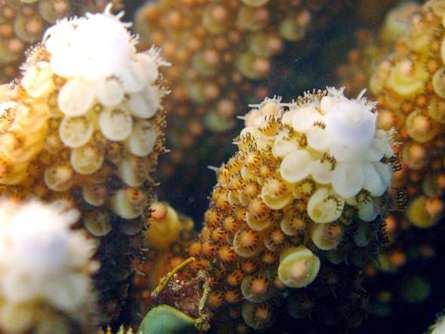Sentimental songs aside, maybe it’s an absence of moonlight that turns the bounding main into a sea of love.

On evenings when the moon lags below the horizon after sunset, twilight takes on an especially blue cast. That color shift, intensifying on nights after the full moon, might cue the remarkably synchronized mass spawning of some marine species, suggests Alison Sweeney of the University of California, Santa Barbara.
Corals, perhaps the most famous of the mass spawners, don’t have central nervous systems or actual eyes. Yet many corals manage to release their eggs and sperm into the water on one or just a few evenings of the year in the same few hours — sometimes just the same 20 minutes — as neighbors of the same species for miles around. Seasonal cues go into this feat, but what interests Sweeney and her colleagues is how species coordinate the fine-scale timing on a particular evening. “This 20-minute precision is pretty tough to explain,” she says.
In a first step to testing the notion of a blue-twilight cue, Sweeney and her colleagues floated sensors and a laptop wedged into an inner tube out to corals in the U.S. Virgin Islands. Measurements showed that the blue shift can be detected underwater, the researchers report in the March 1 Journal of Experimental Biology.
Just two light-sensing pigments of the opsin type, one tuned to greenish and the other to a blue wavelength, would be enough to detect such a shift, the researchers calculate. In recent genetic analyses, opsin pigments have been showing up in abundance in invertebrates, often more abundantly than in people, Sweeney says.
Marine animals often spawn in sync with some phase of the lunar cycle, and twilight’s color changes slightly around the time of the full moon, Sweeney says. Moonlight has a slight reddish tinge. So the waxing moon, which appears in the sky before the sun sets, shifts twilight a little toward the red. A full moon, however, just peeps over the horizon as the sun sets. As the moon wanes, it rises after sunset, leaving twilight bluer.
Spawning corals typically release their bundles of gametes to float toward the ocean surface and mingle in the evening. “It looks like the little pellets inside a bean bag chair,” Sweeney says. She recalls a spawning covering miles of reef in Palau that left a pink slick on the water still visible the next morning. “You come out of the water smelling like rotten flower shop,” she says.
The idea that a shift in twilight could trigger such an event does sound novel to evolutionary biologist Don Levitan of Florida State University in Tallahassee. “This is a correlation that sets up a series of exciting hypotheses that need to be tested,” he says. The idea does sound plausible, comments another biologist who has studied coral spawning, James Guest of the National University of Singapore.
There must be other lunar and daily cues, says Annie Mercier of Memorial University in St. John’s, Canada. She had her colleagues have just described lunar cycles in the reproduction of deep-sea corals and echinoderms 1,000 meters below the surface, where clues to lunar phase remain “elusive,” as she puts it.






